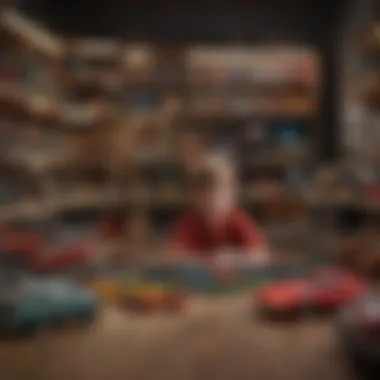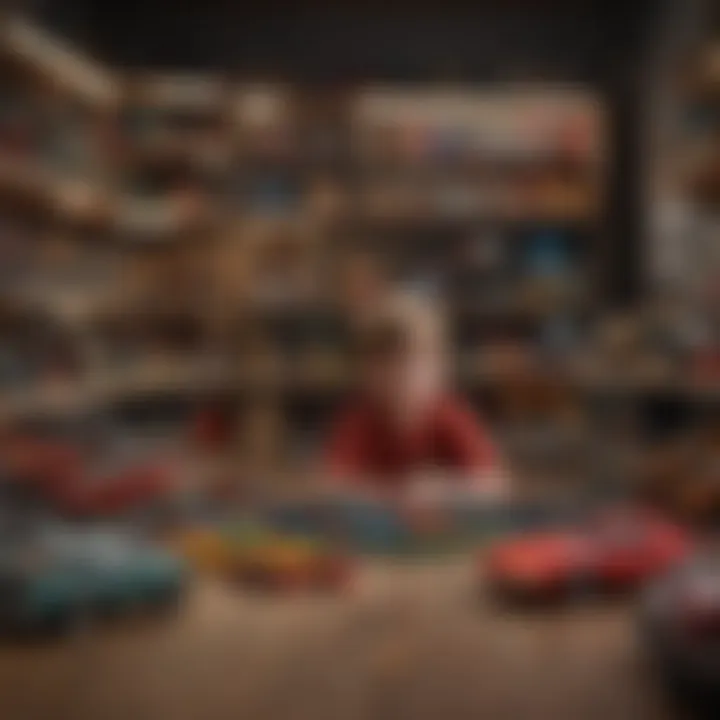Exploring Modular Toy Storage Systems for Organized Living


Intro
Toy storage is a common challenge for many families. Toys can become a chaotic element in a household if not properly managed. Modular toy storage systems provide an elegant solution to this issue. This article explores these innovative systems in detail. We will analyze their design, functionality, and the positive impact they have on organized living spaces. The article will also highlight various types of modular systems, considerations for selecting an appropriate solution, and their influence on child development and family dynamics. Practical tips for implementation and maintenance will be discussed. Lastly, we will examine future trends in modular storage solutions.
Design Inspiration
When designing a modular toy storage system, it is crucial to consider inspiration from current design trends. Many options offer both functional utility and aesthetic appeal.
Trending Styles
The aesthetic of toy storage has evolved. Currently, open shelving and box systems seem to be popular. These systems are flexible and can be arranged in various configurations to fit different spaces. The minimalist style is also trending, focusing on simple lines and uncluttered designs. This allows the toys to be more visible, promoting ease of access while ensuring a serene environment.
Color Palettes
Choosing the right colors can greatly influence the ambiance of a room. Many homeowners opt for soft and neutral shades for the walls, enhancing a calm space. The storage units themselves often utilize bright colors to engage children. Bold reds, spirited yellows, and cool blues create a playful atmosphere, harmonizing with a child’s imagination. However, the key remains balance, ensuring that the colors complement the room’s existing decor.
"Color can greatly influence mood and organization. A thoughtful palette enhances both functionality and aesthetics."
Practical Tips
Implementing and maintaining a modular toy storage system requires careful planning and follow-through. Here are some useful tips for homeowners.
Maintenance & Care
Regular maintenance is essential to keep the storage systems efficient. Periodically, it is important to take inventory of existing toys. Discard or donate items that are no longer used. This not only reduces clutter but also teaches children about sharing. Cleaning the storage units is also vital. A simple wipe down with a damp cloth will keep surfaces fresh and free from dust.
Budgeting & Planning
Before selecting a modular toy storage system, budgeting is necessary. Modular systems range widely in price. It is possible to find affordable options that still offer quality and durability. Always list the features you need and measure the space available. Consider DIY options as well. Some homeowners create bespoke storage solutions from repurposed materials, adding a personalized touch.
Understanding Modular Toy Storage Systems
The infreasing complexity of modern living demands efficient solutions for managing clutter, especially when it comes to children's toys. Modular toy storage systems offer a strategic approach to organizing, maintaining, and maximizing space within homes. By understanding these systems, homeowners can create functional environments conducive to both play and order. This article will guide you through the definition, concept, and principles that form the backbone of successful modular storage solutions.
Definition and Concept
Modular toy storage systems refer to customizable storage solutions consisting of individual units that can be configured, expanded, or redesigned according to specific needs. This flexibility allows the systems to evolve with changing requirements, adapting to the number of toys and the layout of the room. Such systems typically include shelves, bins, and multi-functional furniture that can be rearranged to suit different play areas.
The essence of modular design is its inherent adaptability. For example, a child may have a large collection of toys at one age, but as they grow, the number might decrease or change focus, requiring different storage. These systems allow the ability to make changes without needing to buy entirely new furniture, making them both economical and sustainable.
Principles of Modular Design
Effective modular design incorporates several principles that enhance functionality and user experience. Key principles include:
- Flexibility: Modular designs can be easily modified. Homeowners can add or remove units based on new storage needs or preferences.
- Scalability: As the toy collection grows or shrinks, the storage system can scale accordingly, making it useful over time.
- Versatility: Modular components often serve multiple purposes. For instance, storage units can also function as seating or display areas.
- Ease of Assembly and Disassembly: Many systems enable quick assembly and disassembly, which is especially beneficial during moves or relocations.
"Modular designs empower homeowners to create tailored storage solutions that grow with their needs, fostering a balanced environment for children’s creativity."
Understanding these fundamental concepts and principles allows homeowners to visualize how modular toy storage can work in their spaces. By investing in such systems, families can embrace a culture of organization, promoting responsibility and cleanliness among children. This sets the stage for further exploration of specific types and advantages of modular toy storage systems later in the discussion.
Types of Modular Toy Storage Solutions
Understanding the various types of modular toy storage solutions is crucial for creating an organized and functional living space. These systems cater to different needs and preferences, allowing homeowners to select options that blend style with practicality. Each type offers unique advantages, enabling flexibility in space utilization and improving the overall aesthetics of a room. This section will explore these storage solutions in depth, providing insights into their characteristics, benefits, and how they can be integrated into everyday life.
Open Shelving Units
Open shelving units are a versatile choice for toy storage. They promote easy access to toys and educational materials, making it simpler for children to select what they want to play with. These units typically feature multiple shelves, allowing for toys to be displayed neatly.
One significant advantage of open shelving is the visibility it provides. This can help in teaching children organization skills, as they can see where each item goes. Additionally, open shelves fit smoothly into various home designs. Whether it is a modern minimalist look or a cozy traditional style, they can be customized to complement the environment.
Storage Bins and Boxes
Storage bins and boxes offer a discreet storage option, suitable for managing larger quantities of toys. Unlike shelving, bins can be tucked away under beds, placed in closets, or arranged in playrooms. They help keep clutter to a minimum, as toys can be easily hidden when not in use.
These storage solutions come in various sizes, materials, and colors, allowing them to blend into existing décor seamlessly. Moreover, labeling storage boxes enhances organization, ensuring that both children and adults can quickly find what they need. Regularly rotating toys stored in bins also keeps play experiences fresh, encouraging engagement with different sets.
Multi-functional Furniture


Multi-functional furniture serves a dual purpose, integrating storage solutions with everyday items in the home. For instance, ottomans that open to reveal storage space or benches that double as toy chests can save space while providing utility. This is especially important in smaller living environments where every square foot counts.
By combining functions, multi-functional furniture reduces the need for multiple pieces, simplifying the layout of a room. Additionally, they can enhance the room's aesthetic by serving as a stylish focal point while keeping toys out of sight. This way, they contribute positively to both design and functionality.
Wall-Mounted Solutions
Wall-mounted solutions are ideal for maximizing vertical space in a room. They can include shelves, hooks, or pegboards specifically designed to hold toys or art supplies. This approach is particularly useful in playrooms or children's bedrooms, as it frees up floor space and adds character to the walls.
With a variety of designs available, wall-mounted storage can be both functional and visually appealing. They offer opportunities for creativity, allowing children to personalize their space by arranging their toys in a way that reflects their personalities. The accessibility of toys at different heights also encourages independence in choosing activities for playtime.
Advantages of Modular Toy Storage Systems
Understanding the advantages of modular toy storage systems is crucial for anyone seeking to create an organized and functional living space. These systems offer practical solutions that cater to the diverse needs of families, making them an important consideration in home design and organization. The benefits vary from efficient use of space to fostering a sense of responsibility in children. Below, we explore the specific advantages that these modular systems provide.
Space Optimization
One significant advantage of modular toy storage systems is space optimization. These systems can be tailored to fit various environments, from small apartments to larger homes. Utilizing vertical space effectively allows for more storage without taking up valuable floor area.
- Customizable Dimensions: Modular systems can be designed to match your available space, ensuring full utilization.
- Efficient Layouts: By incorporating shelves, cabinets, and boxes in strategic layouts, you prevent clutter.
- Vertical Expansion: High shelving units can store items out of reach, keeping toys organized yet accessible.
- Placement Flexibility: Modular systems can be easily rearranged as needs change.
By optimizing space, homeowners can create a more streamlined environment conducive to both play and relaxation.
Flexibility and Adaptability
Modular toy storage systems excel in flexibility and adaptability. Life is dynamic, and so are children’s needs. Here are a few important aspects related to this benefit:
- Scalable Design: As the number of toys increases or decreases, the modular unit can adapt. You can add more storage solutions as the child grows or remove them as needed.
- Personalization: These systems often come with options for color and finish. This allows for easy integration into existing decor.
- Multi-Functional Use: Some modular pieces serve dual purposes, such as a storage bin that also acts as seating or a table.
- Seasonal Adjustments: Swap out storage for seasonal items when necessary. For instance, switch to holiday-themed bins during festive seasons.
This adaptability gives modular systems a unique advantage, allowing users to modify them over time rather than committing to a single, less versatile storage solution.
Promoting Responsibility in Children
Another benefit of modular toy storage systems is their potential for promoting responsibility in children. An organized space encourages children to take ownership of their toys, leading to valuable life skills:
- Organizational Skills: Teach children to sort and categorize their toys, developing skills they will use throughout their lives.
- Cleaning Habits: When toys have dedicated homes, cleaning up becomes routine. Children can learn this habit from an early age.
- Decision Making: Choosing where to store their toys fosters decision-making skills. Children learn to assess space and prioritize what is essential.
- Sense of Accomplishment: Completing cleaning tasks can lead to increased self-esteem. Children feel proud when everything is in order.
Incorporating modular toy storage not only enhances organization but also shapes responsible future citizens by instilling positive behaviors towards cleanliness and organization.
Effective use of modular systems can transform spaces while teaching children important values, contributing to a harmonious household.
As we explore modular toy storage systems, it becomes clear these advantages offer more than just aesthetic benefits. They represent a strategic approach to creating functional, adaptable, and responsible living environments.
Choosing the Right Modular Storage System
The selection of a modular storage system for toys is a crucial step in achieving organized living spaces. It is vital to understand that the right system is not simply about utility; it involves balancing functionality, aesthetics, and the specific needs of the household. Every home has unique requirements based on the available space, the age of children, and the tastes of the homeowners. A thoughtful approach to choosing a storage system can have a lasting positive impact on both the environment and daily routines in the home.
Assessing Space Requirements
Before committing to a modular toy storage system, it is essential to assess the available space. Measurements should be taken to determine the dimensions of the intended area. Considerations include not only the size of the room but also the traffic flow and accessibility. Having the exact figures helps in selecting a storage solution that fits comfortably without overwhelming the space.
Important Steps in Assessing Space:
- Measure the height, width, and depth of the space.
- Identify any fixed elements, such as windows, doors, or heating vents that may limit installation options.
- Consider how much room is needed for children to play.
- Think about future changes in space usage. With children growing, the capacity and configuration may need to change over time.
This assessment ensures that whatever system you choose complements rather than complicates the layout of the room.
Considering Child Age and Needs
When selecting a modular storage solution, the age and developmental stage of the children using it are crucial factors. As children grow, their needs and the types of toys they engage with will evolve. For toddlers, secure storage that reduces the risk of accidents is important. In contrast, older children may require systems that promote independence and organization.
Considerations for Different Ages:
- Toddlers: Opt for low, open storage that allows easy access for small hands. Safety is paramount, so avoid sharp edges and ensure items are lightweight.
- Preschoolers: Introduce systems that allow sorting and categorizing toys. Bright colors and engaging designs can encourage them to participate in cleaning up.
- School-age children: Provide options that allow them to organize their toys and school supplies independently. Modular systems that can adapt with changing toy collections, like LEGO or art supplies, can be beneficial.
By considering these factors, the chosen storage system can support healthy development and encourage responsibility among children.
Evaluating Aesthetic Preferences
Aesthetics play a significant role in the selection of modular toy storage systems. It is essential to consider how the storage will integrate with the overall design of the living space. Homeowners should select colors, materials, and styles that align with their existing decor. Clean lines may appeal to modern tastes, while bright colors might suit a more playful atmosphere.


Key Aesthetic Considerations:
- Match the storage system's materials with other furniture in the room to create a cohesive look.
- Consider using transparent bins or boxes to easily identify toys while maintaining a neat appearance.
- Think about how the chosen system can evolve with home decor as it changes over time.
Implementation of Modular Toy Storage
The implementation of modular toy storage systems is crucial for creating a well-organized space. It not only enhances the functionality of a room but also addresses clutter, which can affect both children and adults. A thoughtfully designed storage solution turns chaos into order. Therefore, understanding how to effectively implement these systems can benefit the entire household.
Designing a Functional Layout
When designing a functional layout, it is essential to consider the available space and the types of toys needing storage. Begin by assessing the room layout. Identify which areas are underutilized and can be optimized with modular systems. Choose storage solutions that can fit into different spaces seamlessly. For example, corner shelves can make efficient use of a usually wasted area. Rearranging furniture to create a flow can make the space feel larger and more open.
Moreover, it's crucial to customize the storage for the specific needs of a household. Open shelving units can store frequently used items at accessible heights. Meanwhile, lower bins might be suitable for younger children who need to reach their toys easily. Ensuring that the layout promotes easy access for both children and adults can save time and reduce frustration during play.
Involving Children in the Process
Involving children in the toy storage implementation process is a valuable practice. When children have a say in how their toys are organized, they feel more ownership and responsibility for their belongings. Start by discussing the importance of organization with them. Explain how a tidy space can lead to easier play and even help them find their favorite toys quicker.
Encourage children to choose how they wish to organize their toys. They might prefer sorting by type, color, or size, depending on their personalities. Let them assist in placing toys into the storage solutions, making it a fun activity. For example, allow them to pick which bins to use and where to place them. This teamwork not only fosters independence but also builds a sense of accomplishment when they see the neat space they helped create.
"Implementing organized systems will benefit children by teaching them valuable life skills related to tidiness and responsibility."
Incorporating their choices ensures that the storage layout remains functional for them, making clean-up feel less like a chore and more like a game. Regular reassessment of their needs is necessary to keep the system effective as their interests and toys evolve.
Maintenance and Organization
Maintaining an organized environment is crucial, especially when it involves children's toys. In a house where toys can rapidly accumulate, having a structured approach to maintenance and organization becomes essential. Effective management not only creates a visually appealing space but also improves functionality and accessibility to toys, aiding in a smoother daily routine.
The key benefits of focusing on maintenance and organization include reducing clutter, enhancing safety, and promoting responsibility among children. When toys are organized, it minimizes the chances of accidents, such as tripping. Moreover, it instills in children the habit of putting their toys away, encouraging a sense of ownership regarding their belongings.
Regular maintenance also allows for better assessment of existing storage solutions. As children’s interests and needs evolve, so do their toy collections. Keeping a clean and organized space means being aware of what toys are no longer played with and could be donated or discarded, thus allowing new ones to be incorporated seamlessly.
Routine Cleaning and Decluttering
Creating a routine cleaning schedule is crucial in ensuring that a modular toy storage system remains functional over time. Decluttering can be overwhelming if left for long periods, so integrating this task into a regular household routine prevents build-up. For instance, setting aside time weekly or monthly to evaluate and clean toy areas can make a significant difference.
Here are some effective strategies to incorporate into a cleaning routine:
- Establish a Time Slot: Designate specific times for cleaning. This consistency creates a habit.
- Involve Children: Teach kids to assist in cleaning. This not only eases the workload but also reinforces their responsibility toward their toys.
- Sort and Organize: Use the "keep, donate, throw away" method when assessing toys. This will streamline the process of decluttering.
Reassessing Storage Needs Regularly
Understanding that storage needs may change helps in maintaining an effective modular toy storage system. Children grow, and their preferences shift. Hence, regularly reassessing these storage needs ensures the systems in place continue to serve their purpose effectively.
Consider these aspects:
- Evaluate Toy Usage: Regularly check which toys are being used frequently and which are not. This can guide decisions about what to keep or remove.
- Adjust Storage Solutions: As children’s collections change, consider either swapping out bins for larger ones or adding shelves for better accessibility.
- Monitor Space Availability: Homes may undergo changes as well. New furniture or changes in play areas can affect storage efficiency, prompting reevaluation.
By routinely cleaning, decluttering, and reassessing storage needs, families can maintain a more organized and functional space that supports both the child’s development and the overall household harmony.
Impact on Child Development
Modular toy storage systems do more than just organize toys. Their role in child development is vital. The careful arrangement and accessibility of toys can significantly influence various areas of a child's growth. Parents and caregivers need to understand this connection when designing play spaces.
Fostering Creativity and Imagination
A well-organized storage system allows children to engage with their toys more freely. When toys are easily accessible, kids can explore different play scenarios without frustration. This boosts creativity. They can build, imagine, and create without the barrier of clutter in the way.
Consider how children use toys. A simple block can transform into a castle, spaceship, or anything else. Modular systems, by keeping toys organized, encourage this imaginative play. Children can easily find what they need, leading to longer and more involved play sessions. This immersion is crucial for developing problem-solving skills and creative thinking.
Key points to consider:
- Open shelving allows for easy visibility of toys, fostering the choice and inspiration.
- Storage bins can group similar items, encouraging themed play scenarios.
- A clear, organized space helps reduce distractions, which is important for focused imaginative play.
"The environment shapes a child's ability to engage their imagination."
Encouraging Independence
Independence is a cornerstone of childhood development. Modular toy storage promotes this by allowing children to take charge of their play environments. When children can reach and store their toys independently, they learn responsibility.


Giving children the tools to manage their own play encourages decision-making. Kids decide which toys to take out and which to put away. It becomes part of their routine. They learn the value of organization.
Some design considerations that enhance independence include:
- Low shelving that gives children access to their items.
- Color-coded bins that make it easier for children to find and return toys.
- Labels for bins, allowing kids to learn to recognize words and associate them with items.
By nurturing these skills, modular storage systems become more than functional. They are instrumental in teaching life skills at an early age.
Sustainable Practices in Modular Storage
Sustainable practices in modular storage systems are essential for reducing environmental impact and promoting responsible consumption. They focus on eco-friendly materials, efficient design, and durability. Homeowners and design enthusiasts are more aware of their choices, making sustainability a critical consideration when selecting storage solutions.
Adopting sustainable practices can provide numerous benefits, including:
- Reduced Waste: Utilizing materials that are recyclable or made from recycled products minimizes waste.
- Energy Efficiency: Selecting designs that require less energy for production and maintenance can save resources.
- Health Benefits: Using non-toxic materials ensures a safer environment, especially for children.
These practices not only benefit the planet but also enhance the aesthetic qualities and functionality of living spaces.
Material Selection and Its Importance
Choosing the right materials is crucial in creating modular toy storage that is both functional and sustainable. Here are a few material options:
- Bamboo: A rapidly renewable resource that is strong and lightweight. Ideal for shelves and boxes.
- Reclaimed Wood: Utilizes existing materials, thereby reducing the demand for new lumber.
- Recycled Plastics: These can be molded into various shapes and sizes, offering versatility without the environmental cost of virgin plastics.
Prioritizing materials with a lower ecological footprint can have significant impact over time. Additionally, many sustainable materials have unique aesthetic qualities, allowing for attractive storage solutions.
Designing for Longevity
Creating modular storage that lasts means focusing on durable design. This involves:
- Robust Construction: Choose methods and connections that ensure strength and stability. For instance, using solid wood joints rather than screws can enhance durability.
- Timeless Design: Avoid trends that may quickly become outdated. Instead, select styles that can easily adapt to changing needs or decor.
- Repairability: Look for systems that can be easily repaired rather than replaced. This sustains their longevity and reduces waste.
Sustainable design should emphasize resilience to withstand the test of time, both in terms of physical durability and aesthetic longevity. By taking these steps, homeowners can create systems that not only serve their purpose but also care for the environment.
Future Trends in Modular Toy Storage Systems
The landscape of modular toy storage systems is evolving rapidly. As families seek out solutions that are not only functional but also enhance their living spaces, understanding future trends becomes essential. With the rise of technology and changing aesthetic preferences, the way we organize and store toys reflects broader shifts in design and functionality. Emphasizing adaptability and efficiency, being aware of these trends enables homeowners to make informed decisions when upgrading their storage solutions.
Technological Innovations
The integration of technology into modular toy storage systems is becoming increasingly prevalent. Smart storage units equipped with sensors and apps are now on the market. These innovations allow parents to track inventory, suggesting organization options based on usage patterns. Additionally, features like adjustable shelving heights and removable compartments offer flexibility that adapts to a child's growth and evolving toy collection.
- Smart Storage Systems: These units often come with integrated technology, making it easier to keep track of items. They might feature inventory tracking that helps to ensure no toy gets lost.
- Eco-Friendly Materials: Many manufacturers are shifting toward sustainable materials, such as recycled plastics and renewable wood sources, reducing environmental impact while maintaining durability.
Technological advancements can lead to better user experiences, making management of play areas less burdensome for parents.
Evolving Design Trends
As consumer preferences shift, the aesthetics of modular toy storage systems are also undergoing transformation. The demand for stylish, multi-functional items continues to rise.
- Minimalist Designs: Sleek, minimal looks allow for a clean appearance in play areas. Parents often prefer designs that blend with the overall interior decor.
- Customizable Features: Options that can be tailored to fit individual needs are in higher demand. For example, some systems offer interchangeable components that match the family's evolving tastes.
"Current trends emphasize that storage should not only function well but also be a part of the home decor."
Closure
The conclusion serves as an essential pivot in understanding modular toy storage systems. It ties together the various elements discussed in this article, from types of modular solutions to their influence on child development. An organized environment directly impacts the physical space but also influences the emotional well-being of both children and adults. The benefits of a tidy space enhance focus and creativity, which are vital components in nurturing a child's growth.
Recapping the Importance of Organization
Organization is not merely about aesthetics; it is a functional necessity. When toys are sorted and stored appropriately, children can locate what they need quickly. Moreover, it encourages them to take responsibility for their belongings. Parents benefit, as well, from reduced clutter. A well-organized play area would mean less time spent searching for lost items and more quality time spent engaging with children.
To summarize:
- Ease of Access: Children learn to find and return toys with greater ease when they have clear storage spaces.
- Reduced Stress: A clean and organized area minimizes visual overload, leading to a calmer emotional environment.
- Building Habits: Consistent organization instills a sense of discipline in children, teaching them accountability at an early age.
Encouraging Thoughtful Design Choices
Thoughtful design is crucial in creating a modular toy storage system that works both for children and parents. It involves evaluating not just the aesthetic appeal but also functionality and safety. When selecting storage solutions, consider the materials used. They should be durable and child-friendly. Furthermore, the design must be adaptable to changes, as children's needs evolve over time.
To facilitate mindful selections, here are key considerations:
- Sustainability: Select eco-friendly materials that promote long-lasting use, aligning with contemporary trends in sustainable living.
- Safety Features: Ensure that the design includes rounded edges and stability to prevent accidents.
- Aesthetic Harmony: Aim for a cohesive look that complements existing home decor, creating a seamless transition between play and living spaces.
Ultimately, making informed design choices results in functional storage that contributes to a harmonious home environment.















